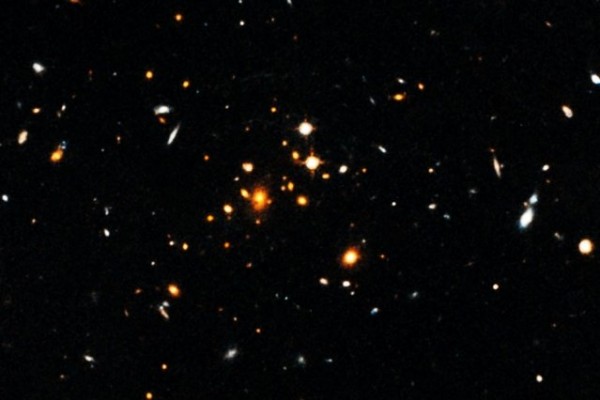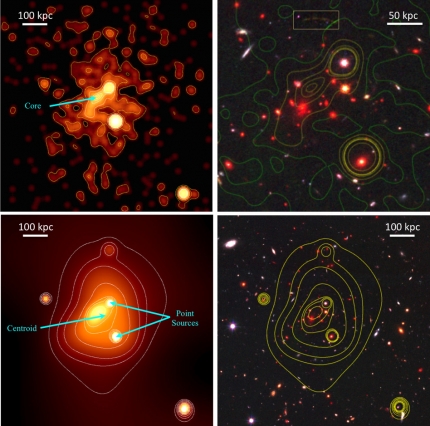
A team of astronomers has detected the most massive cluster of galaxies yet discovered in the first 4 billion years after the Big Bang. The sprawling, churning galaxy cluster – which is labeled IDCS J1426.5+3508 (aka IDCS 1426) – is 10 billion light-years from Earth. It may contain thousands of individual galaxies. It’s about 250 trillion times more massive than the sun, or 1,000 times more massive than the Milky Way galaxy. That’s according to new research presented at the 2016 American Astronomical Society (AAS) meeting in Kissimmee, Florida, last week (January 4-7, 2016).
Galaxy clusters are conglomerations of hundreds to thousands of galaxies bound together by gravity. They are the most massive structures in the universe.
The early universe was a chaotic mess of gas and matter that only began to coalesce into distinct galaxies hundreds of millions of years after the Big Bang. Scientists had previously thought that it would take several billion more years for such galaxies to assemble into massive galaxy clusters.

IDCS 1426 appears to be undergoing a substantial amount of upheaval. The researchers observed a bright knot of X-rays, slightly off-center in the cluster, indicating that the cluster’s core may have shifted some hundred thousand light-years from its center.
The scientists believe that the core may have been dislodged from a violent collision with another massive galaxy cluster, causing the gas within the cluster to slosh around, like wine in a glass that has been suddenly moved.
Researcher Michael McDonald, assistant professor of physics and a member of MIT’s Kavli Center for Astrophysics and Space Research, says such a collision may explain how IDCS 1426 formed so quickly in the early universe, at a time when individual galaxies were only beginning to take shape. In an statement from MIT, McDonald said:
In the grand scheme of things, galaxies probably didn’t start forming until the universe was relatively cool, and yet this thing has popped up very shortly after that. Our guess is that another similarly massive cluster came in and sort of wrecked the place up a bit. That would explain why this is so massive and growing so quickly. It’s the first one to the gate, basically.
Galaxy cluster located relatively nearby, such as the Virgo cluster, are extremely bright and easy to spot in the sky. McDonald said:
They are sort of like cities in space, where all these galaxies live very closely together. In the nearby universe, if you look at one galaxy cluster, you’ve basically seen them all. They all look pretty uniform.
The further back you look, the more different they start to appear.
However, finding galaxy clusters that are farther away in space – and further back in time – is difficult and uncertain.
In 2012, scientists using NASA’s Spitzer Space Telescope first detected signs of IDCS 1426 and made some initial estimates of its mass. McDonald said:
We had some sense of how massive and distant it was, but we weren’t fully convinced. These new results are the nail in the coffin that proves that it is what we initially thought.
To get a more precise estimate of the galaxy cluster’s mass, McDonald and his colleagues used data from the Hubble Space Telescope, the Keck Observatory, and the Chandra X-ray Observatory.
Now, the team is looking for individual galaxies within the cluster to get a sense for how such megastructures can form in the early universe. McDonald said:
This cluster is sort of like a construction site. It’s messy, loud, and dirty, and there’s a lot that’s incomplete. By seeing that incompleteness, we can get a sense for how [galaxy clusters] grow.
So far, we’ve confirmed about a dozen or so galaxies, but we’re just seeing the tip of the iceberg, really.
Enjoying EarthSky? Sign up for our free daily newsletter today!
Bottom line: A team of astronomers have detected sprawling, churning galaxy cluster, named IDCS J1426.5+3508 (or IDCS 1426), 10 billion light years from Earth. The megastructure potentially contains thousands of individual galaxies, and is about 250 trillion times more massive than the sun, or 1,000 times more massive than the Milky Way galaxy. The research was presented at the 2016 American Astronomical Society (AAS) meeting in Kissimmee, Florida, January 4-7, 2016.











